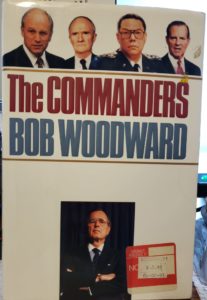
In our garage is a large bookshelf, scavenged years ago when the company was downsizing, that hold the books we trot out whenever we have a garage sale. I finish a book, if it’s not a keeper, I bring it to the shelf and stuff it in somewhere.
As I did that recently, and looking for a new book to read, my eyes fell on The Commanders by Bob Woodward. I knew I’d never read it so pulled it from the shelf. It had belonged to my father-in-law, a book we brought back from his house after his death. The front page included a discussion of an illness he was going through, then in the book he had made much marginalia.
The book interested me because I understood it to be about Desert Storm, a time in history of special importance to me. I figured, knowing Woodward, it was an expose of everything our leaders did wrong. That turned out to false, however. It is more of a simple “here’s how our military operated in that point in time.”
Written mostly in 1989-90 and published in 1991, Woodward describes it as a mixture between journalism and history, a bit more history than newspaper accounts (because of the access he was given to principals) but not quite history with hindsight and full access to documents.
I found the book engaging and informative. The writing style is excellent. Being ex-military, Woodward understands things such as chain of command, relationships between branches of the armed services, and how the military and civilian leadership of our defense establishment works. Being an investigative reporter he knows how to dig out the story.
And dig out the story he did. I won’t go into a lot of details, but Woodward gives us lots of information about Bush, Cheney, Powell, and others involved in using the military as part of our national security strategy. He seems to have had access to Colin Powell and possibly Dick Cheney. These two key figures feature prominently in the book.
Woodward doesn’t paint any one in a bad light in the book. He treats people fairly, explaining where they were, who they talked with, how they made decisions, how they dealt with the press during the run up to the Panama invasion in 1989 and the development of Desert Shield in 1990-91. It ends with the first few attacks the morning that Desert Storm hit an unbelieving Iraq on January 17, 1991.
This is a good book and I recommend it to anyone interested in the early historical accounts of the 1988-91 era. Is it a keeper? Alas, no. Not because of the quality, but because I have too many books and I don’t expect to ever read it again, nor do I expect my wife will want to read it or my future heirs will thank me for leaving it to them to deal with.
So, I will remove the page with the personal note, put that in my father-in-law’s papers, and put the book back in it’s slot on that bookshelf in the garage to await the next sale or donation. The next reader will just have to put up with his marginalia.